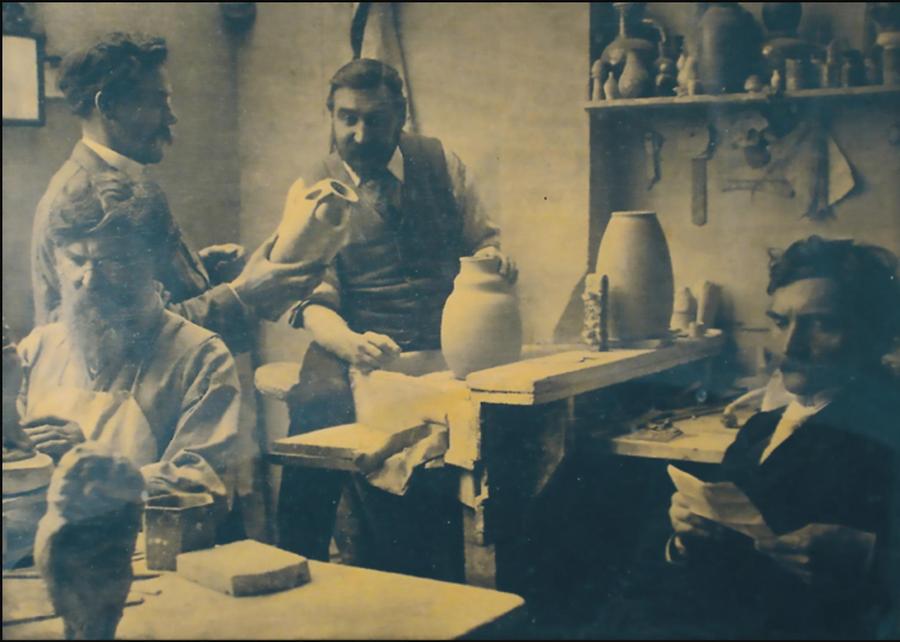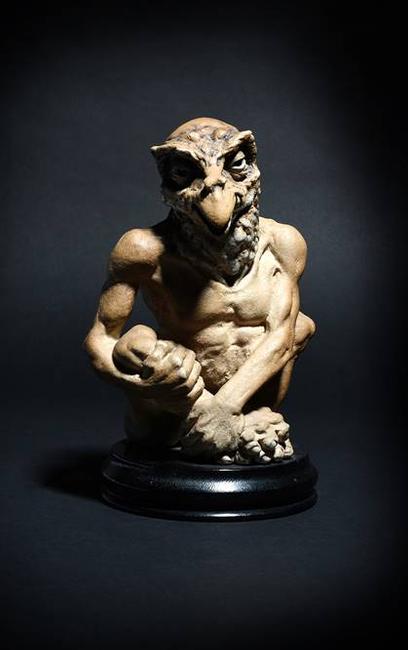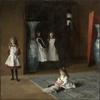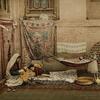A Tragic Tale of Avant-Garde Artist-Brothers Is Behind This $60k 'Laughing Bird' Jar
- SALISBURY, United Kingdom
- /
- October 02, 2019

The 'Laughing Bird' jar is a prized example created by the four innovative Martin brothers, 19th c. British ceramicists whose lives were marred by poverty and tragedies before their work was coveted by the Pre-Raphaelites and later deemed a "national treasure."
At just a few inches high, this extraordinary Victorian creation is among the most prized pieces of ceramics in Britain today and is expected to sell for up to £50,000 ($61,000) at auction on November 27 at Woolley & Wallis in Salisbury, UK.
A Martin Ware stoneware bird jar originally made to hold tobacco, it is part of a surprising, surreal and, for its time, amazingly avant-garde menagerie of animals and characters made and sold as mugs, jugs, jars, vases and even spoon warmers.
They sprang from the vivid imaginations of four brothers, whose genius left behind a valuable legacy with individual pieces running into the hundreds of thousands of pounds, but whose own tale was one of poverty and, ultimately, tragedy.
It all started in the family home in 1873, when the four Martin brothers – Robert Wallace, Walter, Edwin and Charles – fired up their first kiln. Moving to a disused soap works in Southall, west of London, four years later, their 50-year production would come to an end in 1921, when only Robert Wallace, the eldest, was still alive to see bidding at Sotheby’s in London reach £50 for a single bird jar.
It was a poignant moment for a man whose family had only ever known poverty as they struggled to fulfill their artistic dreams – “my brothers and myself never got more than a labourer’s wages”, he said in 1910 – with Robert Wallace modelling the figures, Walter overseeing the kiln, mixing glazes and throwing pots, Edwin decorating the output and Charles managing the shop from where they attempted to sell their wares.
Artistic geniuses they may have been, but when it came to the commercial side of the business they were a uniform disaster, starting with Charles, who hid his favourite pieces under the floorboards of the shop because he could not bear to part with them and turned away potential customers. Eventually, the shop burned down, taking the stock and Charles’s remaining hold on sanity with it. He died in an asylum in 1909, a mere six years after their sister had succumbed to a monkey bite.

The other brothers were little better when it came to the money side. They could only afford to fire the kiln once or twice a year and because they had no money to pay for the protective containers required to hold the pots during firing, many emerged damaged beyond saving after their direct contact with the flames.
Two years after Charles’s death, Edwin started to show signs of the facial cancer that would kill him in 1915; shortly after that Walter knocked his elbow while packing the kiln in 1911. The resulting wound and blood clot caused a fatal cerebral haemorrhage just three months later.

Tragic though their fates may have been, the brothers’ reputation grew quickly, with royalty and leading artistic lights of the day, such as the Pre-Raphaelite painters Edward Burne-Jones and Dante Gabriel Rosetti, becoming avid collectors. In 1914, Queen Mary ordered 60 pieces of Martin Ware to be exhibited at the Paris Exposition.
It was in 1978 that London dealer Richard Dennis staged the landmark exhibition, The Martin Brothers Potters, at Sotheby's Belgravia, complete with a specialist sale that effectively created a new market for Martin Ware. With Malcolm Haslam, Dennis also co-authored the standard work on this field of pottery, entitled The Martin Brothers Potters.
These days prices for Martin Ware have leapt to heights unimaginable to the tear-stained Robert Wallace as he watched a collector pay £50 for a pot at Sotheby’s in 1921. Five years ago, Woolley & Wallis sold one for a record £75,000, while the British government has just put an export bar on another, recently sold for £200,000, because it is now seen as a national treasure.
Now Woolley & Wallis are to offer what has been acknowledged by the leading expert in the field as “the ultimate consummate collection” of Martin Ware alongside another collection of striking rarities. Together the 250 pieces from the Twyman and Fromm collections are expected to fetch around £160,000.
The first specialist to hold dedicated sales of Martin Ware in the UK, back in 2005, Woolley & Wallis’s Head of Design, Michael Jeffery, has twice set the world auction record for a Wally bird, culminating in the £75,000 price in 2014. He has also negotiated the private sale of two large birds of 1896, designed to mimic the Victorian politicians Gladstone and Disraeli, for a record £150,000.
“When the landmark exhibition Boobies, Boojums and Snarks opened in New York in 1981, it recreated the interior of the Martin Brothers’ shop and introduced a whole new generation of Americans to the Wally bird tobacco jars, satyr-mask jugs, spoon warmers and other gothic delights,” says Jeffery. “The market for these wares has been on the rise ever since and when you see the craftsmanship and imagination that has gone into them it is easy to understand why.”
The first collection of some 200 pieces brings together pretty much every type of ware that the Martin Brothers produced. It was put together by George Twyman, who lived within walking distance of the Southall pottery site. He had a lifetime of collecting and championing the Martin Brothers and was even responsible for the official marking of their graves with headstones in 2006. When he died earlier this year, he stipulated in his will that Jeffery should handle the sale.
The other collection is that of Daryl Fromm, a close associate of Twyman, and constitutes around 50 pieces, with some fine examples of the brothers’ best work, including a Wally Bird jar at £30,000-50,000.
Richard Dennis has described Fromm’s as “the ultimate consummate collection” of Martin Ware.
“This unique gathering offers both a wide range of the highest quality pieces and an opportunity to bid on the perfect combination of comic, creepy and grotesque,” says Jeffery. “The craftsmanship is paramount because that is what creates the unbeatable character of Martin Ware and that’s what collectors want.”





















